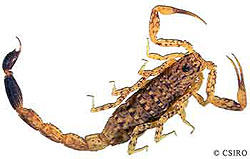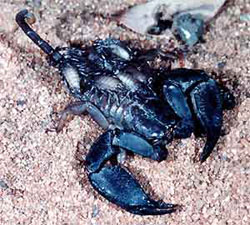|
Scorpions
|

Lychas marmoreus (little marbled scorpion)
|
|
Characteristics
Scorpions
are among the largest arachnids and in Australia some species can
obtain a length of around 12 centimetres. They are easily distinguished
from other invertebrates by the following features:
▪ 4 pairs of
legs
▪ 1 pair of
palps
modified into pincer-like appendages used for grasping and defence
▪ Abdomen which
tapers into a tail with a sting containing a poison gland. The
tail is held over the body in a defensive posture.
The little marbled
scorpion, Lychas marmoreus is one of the most commonly encountered
species in Australia as it happily lives in many urban environments
as well as natural habitats. This species has even been known to
wander into houses causing alarm when discovered hiding under everyday
household objects. In natural habitats these little scorpions can
be found sheltering under the bark of trees, in leaf litter, under
rocks or under the bark of fallen logs. This species feeds on small
insects, but seems especially fond of termites.
In some parts
of the world scorpions are deadly but in Australia they generally
give only a very painful sting. Few human deaths have been recorded
in Australia resulting from scorpion stings. Using an ultraviolet
light source is a good way to locate scorpions in the field as they
are nocturnal and fluoresce brightly under such light at night.
Life Cycle
Male and
female scorpions perform a mating dance where the male grasps the
palps
of the female and manoeuvres her over a sperm packet, which he has
deposited on the ground. She then takes this up into her reproductive
opening. Female scorpions give birth to live young, which resemble
small adults. The female will then carry the young around on her
back for several weeks before they disperse to fend for themselves.
The young will moult
several times before they reach maturity.
Feeding
Scorpions
are nocturnal
predators and feed on a variety of invertebrates. Their prey is
usually captured at night among rocks or under the bark of a tree.
Scorpions seize prey with their pincers and swing their tail up
over the body to strike repeatedly with their sting in the soft,
vulnerable parts of the abdomen of their victims. The prey is dead
almost instantly and the pincers holding it are used to tear up
or sever off small pieces to be passed towards the mouth where the
life juices are squeezed out and consumed. Scorpions are known to
feed on a variety of insects, spiders, centipedes, millipedes and
even other scorpions. Some of the larger species of scorpions may
even feed on vertebrates such as small lizards and snakes.
Habitat
Scorpions
are found all over Australia and many have become successful inhabitants
of deserts. The desert species usually excavate burrows in the ground,
often spiralling underground away from the entrance. Other species
inhabit more forested environments where they can be found under
rocks and logs and also under the bark of trees.

Liocheles waigiensis (common brown scorpion) |
 |
|



